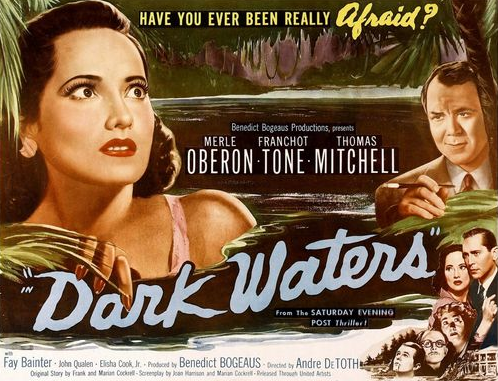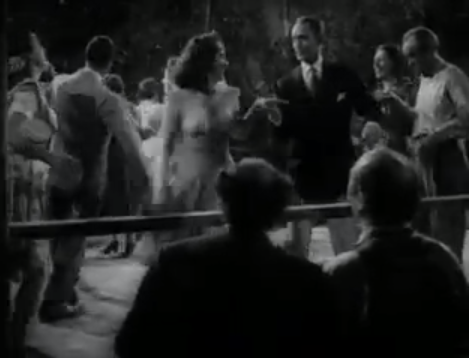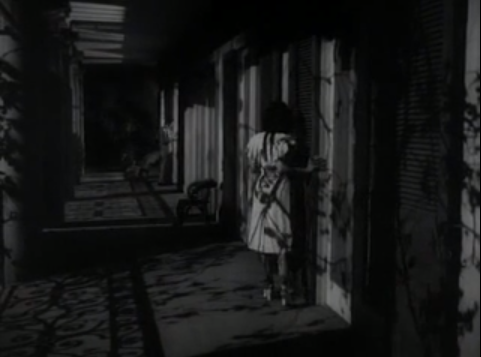Dark Waters

Main Credits
Director: Andre de Toth. Screenplay: Frank Cockrell, Marian Cockrell, Joan Harrison. Producer: Benedict Bogeaus (Benedict Bogeaus Production, as Dark Waters Productions Inc.). Executive Producer: James Nasser. Directors of Photography: John Mescall, Archie Stout. Music: Miklos Rozsa. Art Director: Charles Olds. Editor: James Smith. Cast: Merle Oberon (Leslie Calvin), Franchot Tone (Dr. George Grover), Thomas Mitchell (Mr. Sydney), Fay Bainter (Aunt Emily), Elisha Cook, Jr. (Cleeve), John Qualen (Uncle Norbert), Rex Ingram (Pearson Jackson), Nina Mae McKinney (Florella), Odette Myrtil (Mama Boudreaux), Eugene Borden (Papa Boudreaux). Released: United Artists, November 21, 1944. 90 minutes.
From Film Noir: The Encyclopedia
Plot Summary
Leslie has been traumatized. She is a survivor of a submarine attack. When the ship sank, her parents drowned. She has no friends, and she has never met her only relatives, Aunt Emily and Uncle Norbert. She writes to them from a New Orleans hospital. They invite her to live with them on a defunct plantation in the Louisiana backwoods. George, a local doctor, meets her and immediately lets her know he is attracted to her. At the estate, the slimy Cleeve and the malevolent Sydney keep unnerving her with reminders of her tragedy at sea. Because strange incidents at night make her think she is losing her mind, she turns down George’s marriage proposal. She learns it is a hoax from Pearson, an African American laborer. He is murdered. She discovers Emily and Norbert are imposters, and Cleeve killed her real aunt and uncle. It is not her sanity that is at risk, but her life. Sydney has led a plot to get rid of her and sell the estate. Cleeve and Sydney take Leslie and George out on a boat to kill them. They escape into the bayou. After Cleeve dies horribly in quicksand, Sydney gives himself up to George.
Commentary
Typically, before a woman in distress doubts her sanity, she feels fine. Later she believes she is losing her mind. Suspense is built on her growing fear of going mad. For example, this happens to Paula (Ingrid Bergman) in Gaslight.
In Dark Waters, however, Leslie’s story has the reverse trajectory. At first she is suffering from actual mental trauma. The plot isn’t about her decline, but her recovery. The film indicates the prescription for her cure is socializing.
George takes Leslie to meet the Boudreaux, a happy Cajun family with six children, and she brightens up. Next, he takes her to a fais do do (a Cajun community square dance). Although Emily and Sydney protest against her going, George insists. When Leslie arrives, she scowls and mutters, “I’m not going to have a good time.” He asks her what she said, and she speaks up, “I said I was going to have a good time!” And she really does.

These scenes may seem out of place. In fact, they are critical because they show Leslie’s recovery requires her to enjoy living again, which happens through social interaction, such as dancing. It is dangerous to be alone, like Paula.
Since the rise and fall of mental health for the woman in distress is mirrored in Gaslight and Dark Waters, these films also take the opposite approach to suspense. Tension in Gaslight increases the longer Paula thinks she is cracking up. In contrast, Leslie finds out relatively fast that she isn’t going crazy.
Following some minor incidents that disturb her, Leslie’s worst experience is hearing her name called from the bayou. She goes outside and runs into Pearson, who says he heard it, too. Suspense is sacrificed in Dark Waters in favor of having Leslie know she isn’t delusional.
Furthermore, the noir style is associated with Leslie’s actual predicament, which is her physical well-being, not her psychological plight. The style is insignificant in scenes where mind games are played on her. Instead, the strongest visual style occurs the night she finds herself a prisoner in the dark house. She looks over the second floor banister and sees, in an outstanding deep focus shot, Sydney sitting under a lamp in a room downstairs. Large shadows of the staircase pickets rake across her like cell bars.

Leslie then steps onto the veranda and finds Cleeve and Norbert each guarding one end of it. Shadows of vines entangle her.

In the climax, George tells her to jump off the boat into the bayou. The horror of the lifeboat is gone. She jumps. Instead of water terrifying her with memories of death, it saves her. Unlike Paula in Gaslight, in the conclusion of Dark Waters Leslie doesn’t learn she has been sane all along. George asks her if she is all right. She softly says she is. Behind her, he smiles, aware of what it means. Realizing they can be married, she beams and firmly says it again, “I’m all right!” Her recovery is complete.